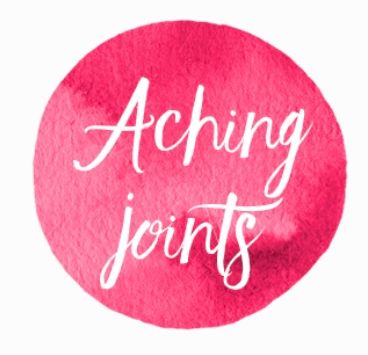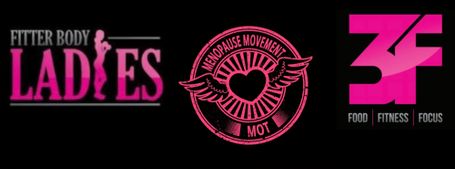
Aching Joints
Backs, knees and hips are most affected, followed by hands, fingers, wrists, shoulders and even your jaw! For some women, these will be no more than minor twinges, but for others it can cause chronic, debilitating pain. R.E.M reckon “Everybody Hurts” but menopausal joint pain means it’s pretty much everything!
WHY NOW?
Wear and tear as we get older can certainly be part of the story, but our hormones also play a major role. While the relationship between joints and oestrogen is still somewhat unclear, it’s thought that oestrogen maintains joint and bone health and dampens inflammation down. Depleting oestrogen levels from peri-menopause onwards may give way to gradual aches and pains, or sudden flare ups.
And the good news is…. For many women, once hormones are balanced - if this is the main cause - joint pain will go.
BE PROACTIVE
The best ways to ease menopause joint aches and pains
Short-term use of over-the-counter painkillers and anti-inflammatory tablets may help. More effective in the long term is improving your self-care and making lifestyle changes could have a greater impact on joint pain management in menopause.
What to eat to help with joint aches and pains
Calcium is essential for bone health; found in dark leafy greens, low fat milk and cheese, fortified soya products, sardines, broccoli, nuts and seeds. According to the National Osteoporosis Society magnesium helps with the metabolism and may maximum calcium absorption, so eat with magnesium-rich foods; natural yogurt, almonds, peanuts, bananas and, avocados.
Vitamin D. Essential for calcium absorption. A study in the American Journal of Clinical Nutrition found vitamin D deficiency may mean your body absorbs only 10 to 15% of the calcium in the food you eat. The best source is sunshine, but we can get some vitamin D from our diet by eating more: oily fish, eggs mushrooms (especially shitake) and fortified cereals, milks, margarines and orange juice.
Essential fatty acids may help reduce inflammation in the body. Eat more: oily fish SMASH - salmon, mackerel anchovies, sardines and halibut, linseeds, chia seeds and walnuts.
Eat more Anti-inflammatory fruit and vegetables, in particular: blackberries, cherries, pomegranates and blueberries. Leafy dark vegetables such as Swiss chard, spinach and kale, plus sprouts, broccoli, cauliflower and cabbage.
What to avoid to help with joint aches and pains
Being a beige food lover!
The Women to Women integrative health clinic (US) identifies a link between digestive problems and joint inflammation, possibly due to a diet high in refined carbohydrates. It could be worth experimenting by cutting out certain products: flour, rice, pasta, sugars and processed foods to see if it has any impact on your pain.
Lifestyle & wellbeing to help with joint aches and pains
Maintain a healthy weight
Even being a few pounds overweight can put your weight bearing hips and knees, under pressure. The Arthritis Foundation (US) say that every pound of extra weight you carry puts about 4 pounds of extra pressure on the knees, while chemicals released by fat also cause inflammation.
Stay fit and active
A New York times article on bone health and ageing, advocates building up muscle strength using low impact exercises; try cycling and exercising in water. Women’s Health Concern promote weight bearing and weight resistance exercise to build up muscle power and stabilise joints as your body works against gravity: walking, climbing stairs, tennis, jogging and working out with light weights, all help. Watch our YouTube vlog Yoga with Annie – Basic Stretching Exercises. Play our Spotify playlist as you exercise.
Consult your doctor before starting an exercise programme if you are experiencing significant aches and pains, especially back pain.
Check out your posture
When you’re feeling achy and stiff, you may over compensate by the way you hold your body, straining muscles and causing spasms. Stretch your skeleton by learning a few simple stretching exercises, watch our YouTube vlog Yoga with Annie – Basic Stretching Exercises. and no slouching!
Stress buster
When stressed your body releases cortisol, which can cause inflammation. Find your own stress-buster to control your cortisol levels, preventing aches and pains. Try yoga, meditation, mindfulness or doing exercise.
Supplements worth trying for joint aches and pains
A number of herbal remedies and supplements are recommended for relieving joint pain. You could try: Glucosamine acts as a natural inflammatory, extracted from shellfish (avoid if you have shellfish allergies). Dr Heather Currie, chair of the British Menopause Society, says that it can be used for joint disorders.
Black Cohosh is a phytoestrogenic plant which mimics the effect of missing oestrogen.
Ginger and Turmeric, both anti-inflammatories, can be added to food or grated and made into a tea or tincture.
Liquorice, the root taken in supplement form – and not as an Allsort! - may help with joint pain due to its anti-inflammatory nature!
Specific menopause vitamin and mineral products such as Vitabiotics Osteocare (many others on the market to choose from).
Hyaluronic acid supplements may help to support joint lubrication.
Devil’s Claw this herb has a similar effect to steroids (without steroid compounds).
Vitamin D NHS Choices says everyone should consider taking a daily supplement containing 10mcg of vitamin D during the autumn and winter. This may be taken as part of a high-quality multivitamin. Whilst these are natural products, herbal supplements can have side effects, interact with other medications and come in different strengths. Check with your doctor if they’re safe for you.
Alternative help for joint aches and pains
Complementary therapy
Acupuncture, massage or osteopathy may help to relieve pain, focussing directly on the area causing discomfort.
Alexander Technique
Well worth trying as their techniques help you to change your habits that contribute towards problems such as back pain, muscle tension and stiffness. Check out their website to find a teacher near you.
When to see your doctor about joint aches and pains
Speak to your doctor to establish any underlying reason for your joint pains. While hormone fluctuations are a likely cause for women over 45, there may be other contributing factors. Options to deal with the pain include prescription medications and your doctor can advise more. For acute joint pain, surgery may be discussed.
And there’s always HRT…
For those women who can take it, HRT may relieve joint pain. NHS Choices says it can be an ‘effective treatment’ for symptoms including ‘achy joints’ in menopausal transition. The usual caveat here, HRT is something to be discussed with your doctor. There are pros and cons to taking it. See our vlog, What is HRT? and our conversation with our gynaecologist, Dr Karen Morton Talking Menopause. We don’t take a view. It’s for you to decide whether it’s for you or not.
And we can help
Your Fbl Team x
© Copyright. All rights reserved.
